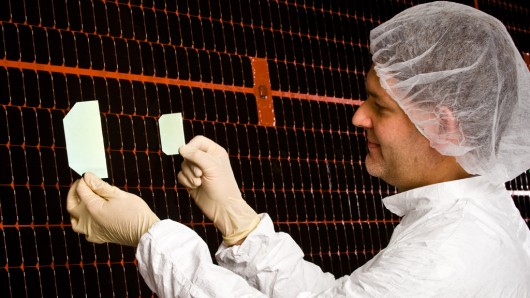Boeing to mass-produce record-breaking 39.2 percent efficiency solar cell
By Darren Quick
17:59 November 24, 2010

Boeing subsidiary Spectrolab has announced it will mass-produce a 39.2 percent efficiency solar cell
When it comes to solar cells, everyone is chasing the highest conversion efficiency. Although we’ve seen conversion efficiencies of over 40 percent achieved with multi-junction solar cells in lab environments, Boeing subsidiary Spectrolab is bringing this kind of efficiency to mass production with the announcement of its C3MJ+ solar cells which boast an average conversion efficiency of 39.2 percent.
As far back as 2006 Spectrolab was achieving conversion efficiencies of over 40 percent in the lab with its high-efficiency multi-junction concentrator solar cells and it reached a peak of 41.6 percent with a test cell last year, setting a new world record. The company’s newest terrestrial concentrator photovoltaic (CPV) cell, called the C3MJ+, uses essentially the same technology as its record breaking test cell and follows on from its C3MJ solar cell in production since mid-2009 which boasts a conversion efficiency of 38.5 percent. The C3MJ+ solar cells
"Given the new cells' close similarity to our existing production cells, we believe that our current C3MJ customers will be able to easily upgrade for more efficiency," said Russ Jones, Spectrolab director of CPV Business Development.
Spectrolab claims the title of the world’s leading supplier of solar cells for satellites with its cells supplying power to around 60 percent of satellites currently in orbit, as well as the International Space Station. Boeing hopes to transfer that success to the terrestrial solar cell market with the new high-efficiency solar cells that are expected to be available from January. And it won’t be resting on its laurels. It expects Spectrolab will achieve a 40 percent average production efficiency for terrestrial solar cells in 2011.
Comments:
Why is it that past patent applications were slapped with a secrecy order? How can we ever get efficient solar panels or power systems for the public? They don't want green eco systems they want to keep selling oil and controlling everyone. We are being held back in every technical area. Look at the terms for restricting patent applications in 1971:-
"Thus, the 1971 list indicates that patents for solar photovoltaic generators were subject to review and possible restriction if the photovoltaics were more than 20% efficient. Energy conversion systems were likewise subject to review and possible restriction if they offered conversion efficiencies %u201Cin excess of 70-80%.%u201D
The Federation of American Scientists has published an extremely important article entitled Invention Secrecy Still Going Strong. It comes from a mainstream organization and corroborates information The Orion Project has presented. We are constantly asked, "If better energy systems exist, why are they not available for public use?" The following article addresses one reason: The systematic suppression of energy inventions by abuse of the national security provisions of U.S. law. This means that thousands of inventions have been suppressed- and more than that number through national security orders not issued via the patent process. This is why the Orion Project has a specific strategy to develop and bring out to the public such energy inventions: One that stands up to these abuses. With your help we can do it!
Invention Secrecy Still Going Strong
Source: FAS Project on Government Secrecy
http://www.fas.org/blog/secrecy/2010/10/invention_secrecy_2010.html
October 21st, 2010 by Steven Aftergood
There were 5,135 inventions that were under secrecy orders at the end of Fiscal Year 2010, the U.S. Patent and Trademark Office told Secrecy News last week. It%u2019s a 1% rise over the year before, and the highest total in more than a decade.
Under the Invention Secrecy Act of 1951, patent applications on new inventions can be subject to secrecy orders restricting their publication if government agencies believe that disclosure would be %u201Cdetrimental to the national security.%u201D
The current list of technology areas that is used to screen patent applications for possible restriction under the Invention Secrecy Act is not publicly available and has been denied under the Freedom of Information Act. (An appeal is pending.) But a previous list dated 1971 and obtained by researcher Michael Ravnitzky is available here (pdf).
Most of the listed technology areas are closely related to military applications. But some of them range more widely.
Thus, the 1971 list indicates that patents for solar photovoltaic generators were subject to review and possible restriction if the photovoltaics were more than 20% efficient. Energy conversion systems were likewise subject to review and possible restriction if they offered conversion efficiencies %u201Cin excess of 70-80%.%u201D
One may fairly ask if disclosure of such technologies could really have been %u201Cdetrimental to the national security,%u201D or whether the opposite would be closer to the truth. One may further ask what comparable advances in technology may be subject to restriction and non-disclosure today. But no answers are forthcoming, and the invention secrecy system persists with no discernible external review.
...
I applaud this achievement. But when I read this I wonder why there is no mention of real cost.
Cost and the amount of resources used, and the importance of how easy it will be to recycle the elements and the length of time the solar cells will last?
Why aren't these questions covered by the author? Every solar article should either give these answers or say we couldn't get any information on these areas.
How much will a system cost for the average household?
What are the resouces used? Especially silicon? Heavy metals.
Is the product easily recycled? We don't want to make a new problem.
How long will the solar cells last? Do they last longer or do they last shorter than the current ones?
These questions should be covered by the author. It's just basic logic.
But I still applaud the possibility that this is something.
Copyright © gizmag 2003 - 2010 To subscribe or visit go to: http://www.gizmag.com